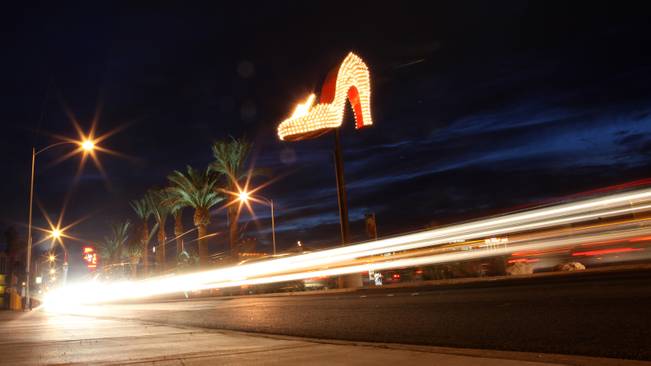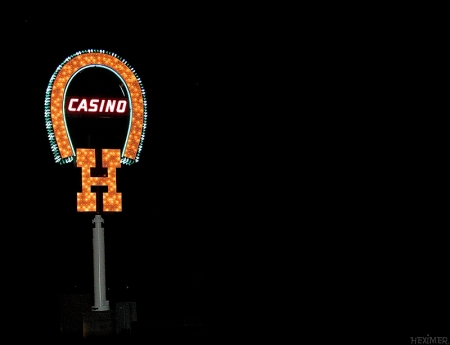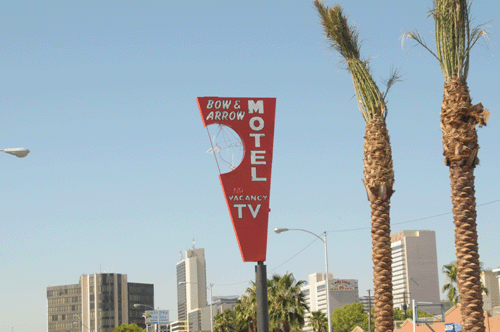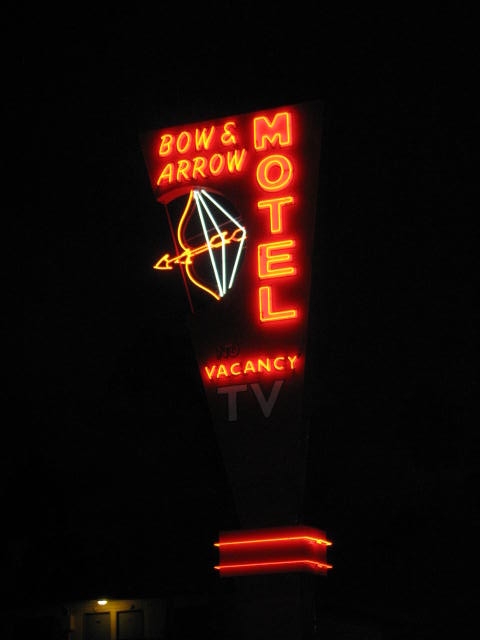Entries in Preservation Issues (114)
City of Las Vegas relights some favorite neon signs
The City of Las Vegas, working with the Neon Museum, has installed three neon signs from the Neon Boneyard. Better yet, on Monday evening, the City held a relighting ceremony as the Bow and Arrow Motel, the Horseshoe "H" and the beloved Silver Slipper were turned back on.

From the Las Vegas Sun:
At first glance, drivers might wonder if there's a giant ladies' footwear sale going on near Cashman Stadium.
But no. That giant sparkling high-heeled shoe perched near the tops of the palm trees along Las Vegas Boulevard North is actually a step back into the city's neon past.
Shimmering with some 980 twinkling lights, the shoe was originally the whimsical icon of the Silver Slipper Gambling Hall that had its heyday nearly a half century ago.
But now the restored 12-by-17-foot three-dimensional shoe is a symbol of the city's commitment to step up to honor its colorful historical main drag.
The Silver Slipper, which also glitters with stories about billionaire recluse Howard Hughes and even "Mr. Las Vegas" Wayne Newton, was one of three historic neon signs turned on at dusk Monday along Las Vegas Boulevard.
With a countdown led by Mayor Oscar Goodman, the three signs were lighted during a ceremony at the Reed Whipple Cultural Center.
"It was 90 years ago, in 1929, that we had the first neon here in Las Vegas turned on," Goodman said. "... We have a unique city, with a unique art form. We preserved it and we're going to continue to preserve it."
The three signs, on loan from the Neon Museum, were lit to celebrate the designation of Las Vegas Boulevard as a National Scenic Byway from Washington Avenue to the north to Sahara Avenue to the south.
"Specifically, in an economy where things are going down, ladies and gentlemen, we continue to bring lights up in the entertainment capital of the world," said Ward 5 Councilman Ricki Barlow.
The designation, granted in October, will help the city to get federal funds to restore as many as 20 historic neon signs in the median in that corridor, Goodman said.

"The city council has made a decision that we're not going to implode our history. We're going to preserve our history," Goodman said.
"That's why we have the Neon Museum across the street, the Neon Boneyard. And now we're beginning to exhibit these things that make us really distinct from any other city. It's a lot of fun, number one. And number two, it has great significance because this is what we're all about. This is where we came from."
He said the city will use Las Vegas Boulevard's new scenic byway as a canvas for painting the city's history with its local art form, neon signs.
"This is our history," he said. "We're unique here in Las Vegas. ... No other place has the kind of art form that we have. I think it's very important when people go up and down this particular road that they're able to share our history with us and enjoy these very iconic locations."
Among dignitaries attending the ceremony was U.S. Rep. Shelley Berkley, D-Nev., who remembered one of the first things she saw upon coming to Las Vegas as a child were the glittering signs.
"I remember through 12-year-old eyes, driving down the Strip for the first time and seeing this extraordinary street with this magnificent neon," she said. "I remember thinking when I was 12 years old this is the most remarkable street I have ever seen. Forty-seven years later I drive down the same street, I have the same reaction and it takes my breath away."
A cultural corridor
City Manager Betsy Fretwell said the highest concentration of cultural institutions in Las Vegas was in the vicinity of the signs, including Cashman Center, the Las Vegas Library, the Natural History Museum, the Lied Discovery Children's Museum, the Neon Museum, the Old Las Vegas Mormon Fort, the State Historic Park and the Reed Whipple Cultural Center.
The first three vintage signed were refurbished and installed in new landscaped median islands for $1.1 million.
About a block to the south of the glittering slipper is the original sign for the Bow & Arrow Motel. At 35-feet tall and six-feet wide, it lights up the median near Bonanza Street with bright red lettering and an animated arrow being strung onto a bow.
The sign was the beacon for the motel that originally located in the downtown on Las Vegas Boulevard at Wyoming Avenue during the late 1950s or early 60s.
To the north, in the median that splits the street into a byway, is another sign that once glittered at Binion's Horseshoe Casino on Fremont Street. The sign was built by Young Electric Sign Company and installed in the 1960s.
The 13-by-12-foot rotating sign features a large golden neon horseshoe trimmed in blue neon lights, with an "H" at the bottom in gold flashing neon and red "CASINO" in the center.
"That's as important as any sign in the community," Goodman said. "When Benny Binion opened the Horseshoe, we established our reputation as being able to take a bet on anything and no limit. And that's what Las Vegas is all about.
Tales of the Silver Slipper
Before the ceremony, William Marion, who chairs the Neon Museum Board, told a story about Howard Hughes' and Wayne Newton's involvement with the Silver Slipper sign.
Hughes, who had moved to the Desert Inn in late 1968 and eventually bought it, had a penthouse directly across the street from the Silver Slipper sign, which was brightly lit and rotated. Hughes made a request that it be turned off.
"They wouldn't shut it off, so he told his aides to buy the property," Marion said. "That's how he got to own the Silver Slipper."
There were other rumors, too, about why Hughes bought the Silver Slipper, including he thought someone had put a camera in its toe that was pointed at his penthouse and spying on him.
Wayne Newton's involvement with the Silver Slipper sign came after Hughes had the sign taken down.
Newton had come to the sign's resting place, in the city's Neon Boneyard, to do promotional shoot years later. And when the 6-foot-3, barrel-chested singer stepped up on its toe, his foot went through it, Marion said.
Colorful characters
Goodman said he used to spend a lot of time over at the Silver Slipper, which he called "one of the original joints, so to speak."
"It had a lot of colorful people who used to hang out there at that part of the Strip," he said.
Goodman, known for his love of martinis, chuckled at the thought of how much of his favorite gin that particular Silver Slipper sign might hold. No, the mayor said. He hadn't done the math.
"Now that you mention it, it takes on a very special significance," he said, chuckling.


Thanks also to Jack LeVine at VeryVintageVegas.com for allowing us to use some of these images
Relighting of the Neon Signs in the Cultural Corridor
From our pals at the City of Las Vegas Historic Preservation Office comes this news:

We think it's wonderful that some of the signs in the Neon Boneyard are being restored and being put back into action!
Kudos to everyone involved!
We hope to see you there!
The Walter Zick/Mid-Century Modern Event

Moderator Lynn Zook (far left), Karen Zick Goff, Claire Zick Walker and Alan Hess
We had a terrific time on Saturday, October 3rd shining the spotlight on Walter Zick and his partner Harris Sharp at our all day event.

The Docents and Volunteers for the Nevada State Museum, Las Vegas prepared a wonderful spread of light finger food, punch and champagne. The anticipated overflow crowd made us move into the History Gallery for the panel. Wise move, because we had almost 100 people in attendance.

Alan Hess talked about what Mid-Century Modern architecture, what it is and why it is important. He also talked about "cultural amnesia". Our past reminds us of who we are, what ideals mattered to us and also shows us how far (or not) we have come. Mid-Century Modern Architecture, perhaps more than others forms of architecture, caught the zeitgeist of post-war America. We were a brash, optimistic country, filled with big dreams and big plans. MCM architecture was filled with much of that same brashness and optimism. Throw in the space race and there seemed no limit to what we could achieve.
"Cultural amnesia" is what we commit, according to Alan, when we tear down our buildings, signage and neighborhoods only because they are old. We lose those links to our past and we don't easily, if at all, get them back.
Alan then spoke at length about the Mint Hotel and why the design of that building and signage still tugs at our memories after all these years.
Walter Zick's daughters, Karen and Claire talked about how their dad had come to Las Vegas in the mid-1940s to work on the Flamingo Hotel.

They talked about growing up in the Twin Lakes (today, Lorenzi Park) neighborhood where the NSM is located today. The first home that their father designed and built for his family is less than a mile west of the Museum on Skolgund Circle. The house included a 50 foot pool that became a homing beacon for pilots flying into Nellis Air Force Base.

Then it was time to get on the bus! and begin our tour of Walter Zick's Mid-Century Modern Las Vegas!

Our first stop was at the Bank of America on West Charleston. It was originally a Bank of Las Vegas, then became a Valley Bank (where my family banked) and is today still in remarkable shape. A drop ceiling, an upstairs addition and the loss of some original windows are the only changes apparent to the interior.

Sara Snodgrass, president of the AIA-S and keeper of our route and schedule and I proclaim proudly for the National Trust for Historic Preservation that "This Place Matters"
Back on the bus and across town we rode to UNLV, passing a number of Zick and Sharp commercial buildings as well as Irwin Molasky's former headquarters and James Brook McDaniel's famous flash cubes!

We rolled onto Maude Frazier Way to see the wonderful Zick and Sharp designed Flora Dungan Humanities Building. It is our understanding that this early 1960s centerpiece of the campus for years is endangered.


Alan Hess points out important features inside Humanities.


FCLV members Joel Rosales and Judy Bundorf declare "This Place Matters" for the National Trust of Historic Preservation.
Back on the bus, to the east side of town to see the first pod school that Zick and Sharp designed, Valley High School. Then it was on to a neighborhood filled with Mid-Century Modern gems as well as the weeping mortar/squish brick home that Zick and Sharp built for Mayme Stocker back in the mid-1940s.

Karen and Claire Zick declare "This Place Matters" for the National Trust for Historic Preservation.
While MaryJOY! Alderman conducted tours of her unique house, Jack LeVine, Friends of Classic Las Vegas supporter and the man behind VeryVintageVegas.com, led those who had taken the house tour down nearby Maria Elena Drive and showed them some stunning homes:


Then it was back on the bus and headed downtown to see the Foley Federal Building, the old Clark County Courthouse and the former Nevada Savings and Loan headquarters before our final stop at the Morelli House. Though Zick and Sharp didn't design the Morelli House, the Junior League of Las Vegas was kind enough to open the house, provide tours and perhaps, most importantly, refreshments!

Dedee Nave and Junior League president, Judy Beale proclaim "This Place Matters" for the National Trust for Historic Preservation.
As it was getting towards twilight, we headed back to the Museum.

We passed by the Neon Museum and saw the three restored signs in the Cultural Corridor!
We arrived safely back and everyone declared it was a great day. We hope to be able to do another event centered around Mid-Century Modern architecture next year.
Alan Hess and I had so many people come up to us and thank us for showing them a side of Las Vegas that they were unaware of, for showing them what Mid-Century Modern architecture is and why it is important.
Karen and Claire were thrilled to have the spotlight shown on their father for a day and were so happy to see the response to their dad's still standing legacy.
Remember, all these places and more MATTER! You can help us to preserve these buildings by becoming a member of the Friends of Classic Las Vegas and a reader of VeryVintageVegas.com

Downtown Steve captures the spirit of the day!
Thank you one last time to everyone who came out for this event, from the reception/panel to those who got on the bus to
Barbara Slivac; the Docents and Volunteers of the NSM, the staff of the NSM, especially Dennis McBride and Tom Dyer;
Karen and Claire Zick; Alan Hess;
the Friends of Classic Las Vegas; VeryVintageVegas.com; Atomic Age Alliance; the Junior League of Las Vegas;
Brian "Paco" Alvarez; Pam Hartley; Zane and Jenny Donaldson, MaryJOY! Alderman and Susan Dean. A special shout-out to the staff of Dona Maria's Downtown for taking such good care of us at the after-event dinner that night.
And lastly, a special thanks to Michael Rosetti and the Double Decker Bus Company!
Let's do it again next year!

Alan Hess to talk on Monday evening

Alan Hess talks Monday night, Oct. 5th, on Mid-Century Modern architect, Paul Revere Williams, and his work in Las Vegas.
The Las Vegas Neon Museum, the City of Las Vegas and assemblageSTUDIO will be sponsoring Alan Hess on Monday October 5th at the 5th Street School at 7PM.
The presentation is the kickoff of the design for the Neon Museum Visitors Center.
Alan's presentation will cover the work of Paul Williams including the La Concha which has been relocated to the Boneyard of the Neon Museum as well as the architectural style of Googie.
Presentation is open to the public and everyone is welcome.

I would like to thank everyone who took part in our fabulous "Beyond the Mint: The Mid-Century Modern Architecture of Walter Zick".
We had a great turn-out for the panel featuring Alan Hess, Claire Zick Walker and Karen Zick Goff and the afternoon bus tour was not only educational but everyone was laughing, joking and having a great time.
We took lots of photos, including at every stop, a photo-op for the National Trust's "This Place Matters"website.
As soon as I get over my exhaustion (three days, three events including one that is all day), I will post a thorough report on the day and provide lots of visuals.
Again, a big thanks to my partner on this, Dennis McBride as well as MaryJOY! Alderman for letting us tour her home, Jack LeVine for his help in getting out the word on this great event, Pam Hartley for her help in putting together the bus route, Sara Snodgrass, president of AIA-S for keeping the bus driver on route and Susan Deane and Zane and Jenny Donaldson and Brian "Paco" Alvarez for making sure no tour patron was left behind at any our stops.
If you were part of our big Zick day, I encourage you to leave comments here about your experience or email me with them and I will include them in the upcoming follow-up report.
My thanks also to Nevada Humanities, Nevada State Museum, Las Vegas; Friends of Classic Las Vegas; VeryVintageVegas; Atomic Age Alliance, the Junior League of Las Vegas and Brian "Paco" Alvarez for their generous financial support.
And lastly, my buddy, Eric Lynxwiler, for his great posters and tour booklets.
And now, I'm going to take a nap!
Untold Stories- This Thursday- The Moulin Rouge

On October 1st, we are focusing on the history and myth surrounding the famed Moulin Rouge Hotel on the Westside of Las Vegas.
The hotel opened in 1955 as the first integrated hotel and casino in town. The opening night was attended by some of the biggest names in entertainment. Everyone had high hopes for this wonderfully designed (by Walter Zick and Harris Sharp) hotel with its giant, neon-script sign (designed by Betty Willis).
The hotel seemed to flourish and stories have been handed down over the years of deserted casinos on the Strip late at night because everyone was at the Moulin Rouge gambling, hanging out and enjoying the jam sessions and the late, late show.
In less than two years, it was closed. Rumors have been rife for years of the mob being involved, of financial improprieties and more.
On Thursday, Oct, 1st, we will try to distinquish fact from fiction, history from myth and try to discern what really happened.
Joining us on the panel will be:
Carrie Pollard, dancer who performed at the Moulin Rouge back in 1955
Trish Geran, local author who focuses on the African-American stories of Las Vegas and who's grandmother ran one of the most famous boarding rooms for African-American performers.
Claytee White, director of the Oral History Research Center at UNLV,
Richard Taylor, local historian who has written two books on the history of the Rouge.
Also, I will have a DVD presentation with rare and rarely seen photos of the Moulin Rouge on opening day.
Thursday, Oct. 1st
Las Vegas Springs Preserve
Desert Learning Center
6:30 pm
Admission $9 (note the new lower price!), (discount tickets available if you buy the next three months).
We hope to see you there!


Photos from the Jay Florian Mitchell collection, courtesy of the Nevada State Museum, Las Vegas


